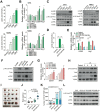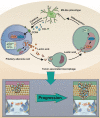Lactate-induced M2 polarization of tumor-associated macrophages promotes the invasion of pituitary adenoma by secreting CCL17
- PMID: 33664865
- PMCID: PMC7914368
- DOI: 10.7150/thno.53749
Lactate-induced M2 polarization of tumor-associated macrophages promotes the invasion of pituitary adenoma by secreting CCL17
Abstract
Background: Lactate greatly contributes to the regulation of intracellular communication within the tumor microenvironment (TME). However, the role of lactate in pituitary adenoma (PA) invasion is unclear. In this study, we aimed to clarify the effects of lactate on the TME and the effects of TME on PA invasion. Methods: To explore the correlation between TME acidosis and tumor invasion, LDHA and LAMP2 expression levels were quantified in invasive (n = 32) and noninvasive (n = 32) PA samples. The correlation between immune cell infiltration and tumor invasion was evaluated in 64 PAs. Critical chemokine and key signaling pathway components were detected by qPCR, Western blotting, siRNA knockdown, and specific inhibitors. The functional consequences of CCR4 signaling inhibition were evaluated in vitro and in vivo. Results: Lactate was positively associated with PA invasion. Of the 64 PA tissues, invasive PAs were related to high infiltration of M2-like tumor-associated macrophages (TAMs) (P < 0.05). Moreover, lactate secreted from PA cells facilitated M2 polarization via the mTORC2 and ERK signaling pathways, while activated TAMs secreted CCL17 to promote PA invasion via the CCL17/CCR4/mTORC1 axis. According to univariate analysis of clinical data, high CCL17 expression was associated with larger tumor size (P = 0.0438), greater invasion (P = 0.0334), and higher susceptibility to postoperative recurrence (P = 0.0195) in human PAs. Conclusion: This study illustrates the dynamics between PA cells and immune TME in promoting PA invasion via M2 polarization. CCL17 levels in the TME are related to the PA invasiveness and clinical prognosis, and the CCL17/CCR4/mTOCR1 axis may serve as potential therapeutic targets for Pas.
Keywords: CCL17; lactate acid; mTOR; macrophages; pituitary adenoma.
© The author(s).
Conflict of interest statement
Competing Interests: The authors have declared that no competing interest exists.
Figures







Similar articles
-
Tumor-associated macrophages promote prostate cancer migration through activation of the CCL22-CCR4 axis.Oncotarget. 2017 Feb 7;8(6):9739-9751. doi: 10.18632/oncotarget.14185. Oncotarget. 2017. PMID: 28039457 Free PMC article.
-
Lactate dehydrogenase A promotes the invasion and proliferation of pituitary adenoma.Sci Rep. 2017 Jul 5;7(1):4734. doi: 10.1038/s41598-017-04366-5. Sci Rep. 2017. PMID: 28680051 Free PMC article.
-
The CCL17-CCR4 axis between endometrial stromal cells and macrophages contributes to the high levels of IL-6 in ectopic milieu.Am J Reprod Immunol. 2017 Aug;78(2). doi: 10.1111/aji.12644. Epub 2017 Feb 27. Am J Reprod Immunol. 2017. PMID: 28240436
-
Tumor-Associated Macrophages: New Horizons for Pituitary Adenoma Researches.Front Endocrinol (Lausanne). 2021 Dec 2;12:785050. doi: 10.3389/fendo.2021.785050. eCollection 2021. Front Endocrinol (Lausanne). 2021. PMID: 34925244 Free PMC article. Review.
-
Tumor microenvironment signaling and therapeutics in cancer progression.Cancer Commun (Lond). 2023 May;43(5):525-561. doi: 10.1002/cac2.12416. Epub 2023 Apr 2. Cancer Commun (Lond). 2023. PMID: 37005490 Free PMC article. Review.
Cited by
-
A New Genetic Signature of Lactate Metabolism-Associated Genes Predicting Clinically Distinctive Features and Tumor Microenvironment in Colorectal Cancer.Cancer Control. 2024 Jan-Dec;31:10732748241272721. doi: 10.1177/10732748241272721. Cancer Control. 2024. PMID: 39121198 Free PMC article.
-
CCL17 exerts neuroprotection through activation of CCR4/mTORC2 axis in microglia after subarachnoid haemorrhage in rats.Stroke Vasc Neurol. 2022 Jul 26;8(1):4-16. doi: 10.1136/svn-2022-001659. Online ahead of print. Stroke Vasc Neurol. 2022. PMID: 35882433 Free PMC article.
-
Identification of novel lactate metabolism-related lncRNAs with prognostic value for bladder cancer.Front Pharmacol. 2023 Sep 13;14:1215296. doi: 10.3389/fphar.2023.1215296. eCollection 2023. Front Pharmacol. 2023. PMID: 37781694 Free PMC article.
-
The Therapeutic Potential of Physical Exercise in Cancer: The Role of Chemokines.Int J Mol Sci. 2024 Dec 23;25(24):13740. doi: 10.3390/ijms252413740. Int J Mol Sci. 2024. PMID: 39769501 Free PMC article. Review.
-
Gut microbiota and tumor-associated macrophages: potential in tumor diagnosis and treatment.Gut Microbes. 2023 Dec;15(2):2276314. doi: 10.1080/19490976.2023.2276314. Epub 2023 Nov 9. Gut Microbes. 2023. PMID: 37943609 Free PMC article. Review.
References
-
- Molitch ME. Diagnosis and Treatment of Pituitary Adenomas: A Review. JAMA. 2017;317:516–24. - PubMed
-
- Di Ieva A, Rotondo F, Syro LV, Cusimano MD, Kovacs K. Aggressive pituitary adenomas-diagnosis and emerging treatments. Nat Rev Endocrinol. 2014;10:423–35. - PubMed
-
- Ippolito L, Morandi A, Giannoni E, Chiarugi P. Lactate: A Metabolic Driver in the Tumour Landscape. Trends Biochem Sci. 2019;44:153–66. - PubMed
Publication types
MeSH terms
Substances
LinkOut - more resources
Full Text Sources
Other Literature Sources
Medical
Miscellaneous

